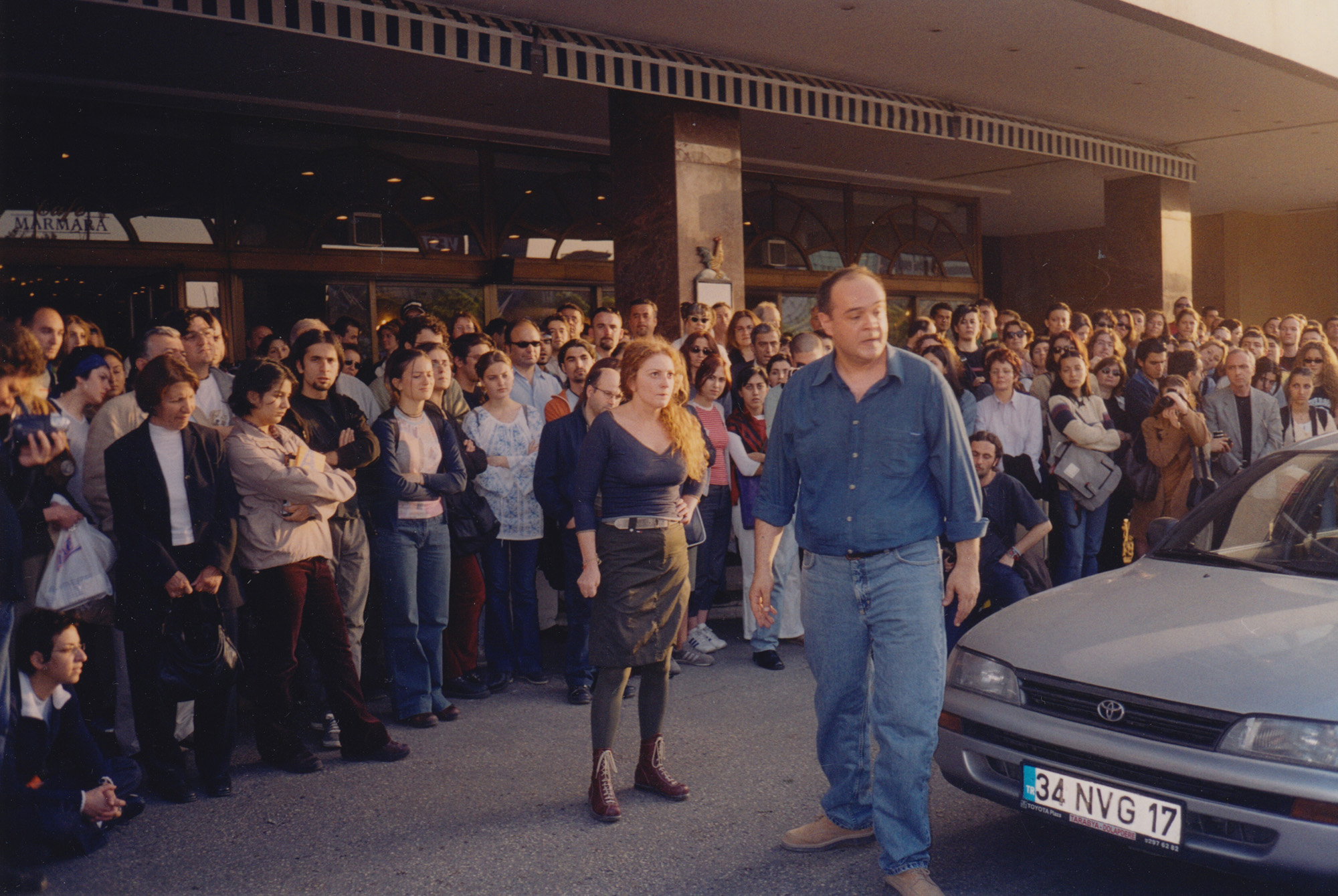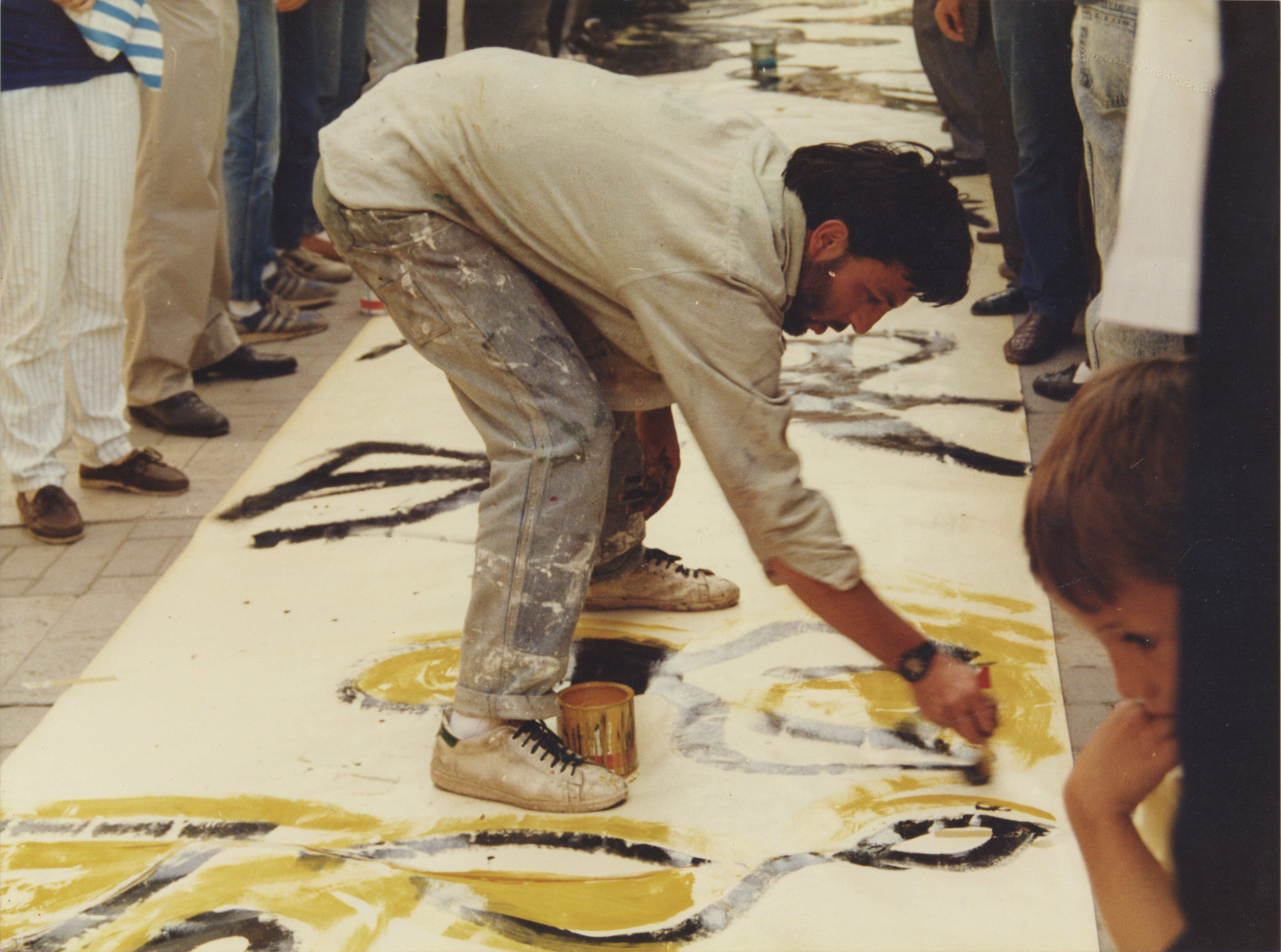Revisiting the ’90s
By Seda Yildiz

Installation view of "The 90s Onstage" at Salt Beyoglu, Istanbul, 2022-23. Photo by Mustafa Hazneci. Courtesy Salt.
“The 90s Onstage” offered an overview of Turkey’s art and cultural scene in the 1990s, a time of social and cultural revival with a focus on performance and its relation to the society, streets, economy, and politics in Turkey. Through a selection of documentation and archival materials of the art and cultural events from the ’90s, the exhibition revisited the era as a decade of optimism and progressive ideas when experimental and site-specific works flourished. The decade marked a period of artistic collaborations that were experimental in nature followed by the introduction of the term “interdisciplinary” into the culture.
Installed across both Salt Galata and Salt Beyoğlu, the exhibition collected an archive of materials: photographs, live performances, video recordings, objects, sketches, printed material and correspondence from selected events spanning from 1988 to the early 2000s. A selection of moving images such as TV program segments, Turkish pop music videos, and the 1996 Fenerbahçe-Galatasaray derby—“a spontaneous performance in the country’s recent football history”—were displayed as a part of the local history of performance art, offering an expanded understanding of performance as a medium.

IBRAHIM AKYUREK‘s Gazhaneler’de Senlik Var (Festival at Gasworks), 1992, photograph, dimensions variable. Courtesy the photographer.

Installation view of SELCUK GURISIK’s Assos Ruhundan, 2022, multimedia installation, dimensions variable, at "The 90s Onstage," Salt Beyoglu, Istanbul, 2022. Photo by Mustafa Hazneci. Courtesy Salt.
The decade was notable for expanding the confines of artistic practice, from studios, galleries, and museums to the public sphere, where the city and streets became exhibition spaces for cultural and artistic activity. The exhibitions “Seretonin I” (1989) and “Seretonin II” (1992), for example, were held at İstanbul’s industrial heritage buildings, Feshane, the first textile institution in the country and built in 1839, and Yedikule Gashouse. On display were project drafts, sketches, press releases, and reviews, as well as documentary photographs and installations of these two events. Both exhibitions exemplified the era’s alternative, non-conformist approach to display art in the city: from content creation to sponsorship and press relations, all steps of the festival were realized collectively by the artists. Among the materials on view was a recording of painter Komet’s reading of a Turkish dictionary inside a cage, a performance that was a critical response to the increasing restrictions on freedom of speech.
Another example of how performance transcended into everyday life was The Assos Performing Arts Festival, which took place between 1995 and 1999, in Behramkale village and the ancient city of Assos on the Aegean coast of Turkey. Rethinking the rural-urban divide, the festival was initiated and run by Hüseyin Katırcıoğlu, an actor and artist who was a part of a wave of returning emigrants from UK who helped to reshape the city in the ’90s. Katırcıoğlu’s encouragement was idiosyncratic of the era generated by a young group of artists while institutionalization was not yet in progress. Along with the archival materials of the festival such as photographs, project drafts, posters, and a video interview with Katırcıoğlu, the festival’s costume designer Selçuk Gürışık produced an installation of felt and gauze masks and sculptures with local artisans. Floating in space, Gürışık’s colorful masks, puppets and costumes, From the Spirit of Assos (1993— ), incorporated traditional methods of production. The festival not only offered a liberating, interdisciplinary approach, bringing together dance, theater, puppetry, visual arts, and music, but was an experiment of art production through collaboration. Invited local and international artists stayed in the village for three weeks to work on a new production. The locals also took an active role in the production, taking care of the decor and costumes, preparing meals, and occasionally acting in pieces. The village became a stage for unexpected encounters from the pier to the archaeological landmarks, with each corner of the village activated.

Photo documentation of KUMPANYA’s What is it this time?, 2002, performance, duration variable, at Marmara Taksim Hotel, Istanbul. Courtesy Kumpanya archive.

Photo documentation of MONI SALIM OZGILIK’s The Legend of Sakarya, 1988, performance, duration variable, Ankara, 1988. Courtesy Salt Research and Moni Salim Ozgilik Archive.
Many practitioners featured in the show utilized and activated public space. Theater company Kumpanya’s short plays, such as What is it this time? (2002) featured arguments without a story, starting and ending abruptly between two people, and took place in open spaces around the city of Istanbul, drawing in audiences to the unexpected encounter. In his performance piece titled The Legend of Sakarya (1988), Moni Salim Özgilik laid a canvas in one of the busiest streets of the capital Ankara and proceeded to draw and color the shadows of people who gathered around. Both opened up artistic practice to a wider audience and not necessarily those who were part of the art world.
“The 90s Onstage” was an uplifting show, going beyond the “dark side of the 90s” and offering a perspective of liberation in terms of artistic possibilities. The show provided alternative forms of art production and presentation—self-organization, self-management, and collective endeavors—that subverted established models, independent of the market, state, or institutional structures. Artistic interventionism taking over the streets while rethinking the center-periphery, builds often-unexpected connections and presents encouraging, counter-hegemonic models that remain as transformative today as it was back in the ’90s.
“The 90s Onstage” is on view at Salt Salt Beyoğlu and Salt Galata, Istanbul from September 15, 2022 to April 2, 2023.







